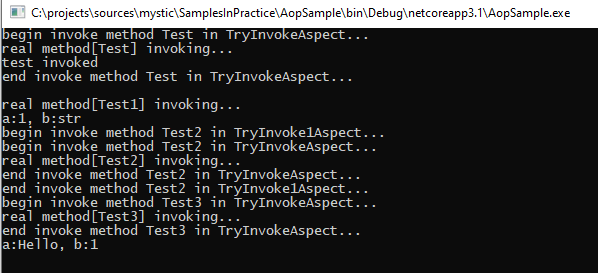實現一個基於動態代理的 AOP
實現一個基於動態代理的 AOP
Intro
上次看基於動態代理的 AOP 框架實現,立了一個 Flag, 自己寫一個簡單的 AOP 實現示例,今天過來填坑了
目前的實現是基於 Emit 來做的,後面有時間再寫一個基於 Roslyn 來實現的示例
效果演示
演示程式碼:
切面邏輯定義:
public class TryInvokeAspect : AbstractAspect { public override void Invoke(MethodInvocationContext methodInvocationContext, Action next) { Console.WriteLine($"begin invoke method {methodInvocationContext.ProxyMethod.Name} in {GetType().Name}..."); try { next(); } catch (Exception e) { Console.WriteLine($"Invoke {methodInvocationContext.ProxyMethod.DeclaringType?.FullName}.{methodInvocationContext.ProxyMethod.Name} exception"); Console.WriteLine(e); } Console.WriteLine($"end invoke method {methodInvocationContext.ProxyMethod.Name} in {GetType().Name}..."); } } public class TryInvoke1Aspect : AbstractAspect { public override void Invoke(MethodInvocationContext methodInvocationContext, Action next) { Console.WriteLine($"begin invoke method {methodInvocationContext.ProxyMethod.Name} in {GetType().Name}..."); try { next(); } catch (Exception e) { Console.WriteLine($"Invoke {methodInvocationContext.ProxyMethod.DeclaringType?.FullName}.{methodInvocationContext.ProxyMethod.Name} exception"); Console.WriteLine(e); } Console.WriteLine($"end invoke method {methodInvocationContext.ProxyMethod.Name} in {GetType().Name}..."); } } public class TryInvoke2Aspect : AbstractAspect { public override void Invoke(MethodInvocationContext methodInvocationContext, Action next) { Console.WriteLine($"begin invoke method {methodInvocationContext.ProxyMethod.Name} in {GetType().Name}..."); try { next(); } catch (Exception e) { Console.WriteLine($"Invoke {methodInvocationContext.ProxyMethod.DeclaringType?.FullName}.{methodInvocationContext.ProxyMethod.Name} exception"); Console.WriteLine(e); } Console.WriteLine($"end invoke method {methodInvocationContext.ProxyMethod.Name} in {GetType().Name}..."); } }
測試服務定義
// 測試介面定義 public interface ITestService { [TryInvokeAspect] void Test(); [TryInvokeAspect] [TryInvoke1Aspect] [TryInvoke2Aspect] void Test1(int a, string b); [TryInvokeAspect] string Test2(); [TryInvokeAspect] int Test3(); } // 測試介面例項定義 public class TestService : ITestService { [TryInvokeAspect] public virtual string TestProp { get; set; } public void Test() { Console.WriteLine("test invoked"); } public virtual void Test1(int a, string b) { Console.WriteLine($"a:{a}, b:{b}"); } [TryInvoke1Aspect] public virtual string Test2() { return "Hello"; } [TryInvokeAspect] public virtual int Test3() { return 1; } }
測試程式碼:
//var testService = ProxyGenerator.Instance.CreateInterfaceProxy<ITestService>(); var testService = ProxyGenerator.Instance.CreateInterfaceProxy<ITestService, TestService>(); // var testService = ProxyGenerator.Instance.CreateClassProxy<TestService>(); // testService.TestProp = "12133"; testService.Test(); Console.WriteLine(); testService.Test1(1, "str"); var a = testService.Test2(); var b = testService.Test3(); Console.WriteLine($"a:{a}, b:{b}"); Console.ReadLine();
輸出效果:

整體結構
ProxyGenerator
ProxyGenerator 代理生成器,用來建立代理物件
public class ProxyGenerator
{
public static readonly ProxyGenerator Instance = new ProxyGenerator();
public object CreateInterfaceProxy(Type interfaceType)
{
var type = ProxyUtil.CreateInterfaceProxy(interfaceType);
return Activator.CreateInstance(type);
}
public object CreateInterfaceProxy(Type interfaceType, Type implementationType)
{
var type = ProxyUtil.CreateInterfaceProxy(interfaceType, implementationType);
return Activator.CreateInstance(type);
}
public object CreateClassProxy(Type classType, params Type[] interfaceTypes)
{
var type = ProxyUtil.CreateClassProxy(classType, interfaceTypes);
return Activator.CreateInstance(type);
}
public object CreateClassProxy(Type classType, Type implementationType, params Type[] interfaceTypes)
{
var type = ProxyUtil.CreateClassProxy(implementationType, interfaceTypes);
return Activator.CreateInstance(type);
}
}
為了更方便的使用泛型,定義了幾個擴充套件方法:
public static class Extensions
{
public static TInterface CreateInterfaceProxy<TInterface>(this ProxyGenerator proxyGenerator) =>
(TInterface)proxyGenerator.CreateInterfaceProxy(typeof(TInterface));
public static TInterface CreateInterfaceProxy<TInterface, TImplement>(this ProxyGenerator proxyGenerator) where TImplement : TInterface =>
(TInterface)proxyGenerator.CreateInterfaceProxy(typeof(TInterface), typeof(TImplement));
public static TClass CreateClassProxy<TClass>(this ProxyGenerator proxyGenerator) where TClass : class =>
(TClass)proxyGenerator.CreateClassProxy(typeof(TClass));
public static TClass CreateClassProxy<TClass, TImplement>(this ProxyGenerator proxyGenerator) where TImplement : TClass =>
(TClass)proxyGenerator.CreateClassProxy(typeof(TClass), typeof(TImplement));
}
AbstractAspect
AbstractAspect 切面抽象類,繼承了 Attribute,可以繼承它來實現自己的切面邏輯
public abstract class AbstractAspect : Attribute
{
public abstract void Invoke(MethodInvocationContext methodInvocationContext, Action next);
}
MethodInvocationContext
MethodInvocationContext 方法執行上下文,包含了執行方法時的原始方法資訊以及代理方法資訊,方法引數,方法返回值
public class MethodInvocationContext
{
public MethodInfo ProxyMethod { get; }
public MethodInfo MethodBase { get; }
public object ProxyTarget { get; }
public object Target { get; }
public object[] Parameters { get; }
public object ReturnValue { get; set; }
public MethodInvocationContext(MethodInfo method, MethodInfo methodBase, object proxyTarget, object target, object[] parameters)
{
ProxyMethod = method;
MethodBase = methodBase;
ProxyTarget = proxyTarget;
Target = target;
Parameters = parameters;
}
}
代理方法邏輯
生成代理的方法在上一節已經介紹,主要就是通過 Emit 生成代理類,要寫一些 Emit 程式碼, Emit 不在今天的討論範圍內,這裡不多介紹,生成代理方法的時候,會檢查方法上的 Attribute ,如果是切面邏輯就註冊切面邏輯,最後像 asp.net core 中介軟體一樣組裝在一起拼成一個委託。
核心程式碼如下:
// var invocation = new MethodInvocationContext(method, methodBase, this, parameters);
var localAspectInvocation = il.DeclareLocal(typeof(MethodInvocationContext));
il.Emit(OpCodes.Ldloc, localCurrentMethod);
il.Emit(OpCodes.Ldloc, localMethodBase);
il.Emit(OpCodes.Ldarg_0);
il.Emit(OpCodes.Ldloc, localTarget);
il.Emit(OpCodes.Ldloc, localParameters);
// 建立一個 MethodInvocationContext 例項
il.New(typeof(MethodInvocationContext).GetConstructors()[0]);
il.Emit(OpCodes.Stloc, localAspectInvocation);
// AspectDelegate.InvokeAspectDelegate(invocation);
il.Emit(OpCodes.Ldloc, localAspectInvocation);
var invokeAspectDelegateMethod =
typeof(AspectDelegate).GetMethod(nameof(AspectDelegate.InvokeAspectDelegate));
// 執行方法以及註冊的切面邏輯
il.Call(invokeAspectDelegateMethod);
il.Emit(OpCodes.Nop);
if (method.ReturnType != typeof(void))
{
// 獲取方法返回值
il.Emit(OpCodes.Ldloc, localAspectInvocation);
var getMethod = typeof(MethodInvocationContext).GetProperty("ReturnValue").GetGetMethod();
il.EmitCall(OpCodes.Callvirt, getMethod, Type.EmptyTypes);
if (method.ReturnType.IsValueType)
{
// 如果是值型別,做一下型別轉換
il.EmitCastToType(typeof(object), method.ReturnType);
}
il.Emit(OpCodes.Stloc, localReturnValue);
il.Emit(OpCodes.Ldloc, localReturnValue);
}
il.Emit(OpCodes.Ret);
註冊並執行切面邏輯程式碼實現:
// 快取方法體執行的委託,包含切面邏輯的執行和方法的呼叫
private static readonly ConcurrentDictionary<string, Action<MethodInvocationContext>> _aspectDelegates = new ConcurrentDictionary<string, Action<MethodInvocationContext>>();
public static void InvokeAspectDelegate(MethodInvocationContext context)
{
var action = _aspectDelegates.GetOrAdd($"{context.ProxyMethod.DeclaringType}.{context.ProxyMethod}", m =>
{
// 獲取切面邏輯,這裡根據切面型別做了一個去重
var aspects = new List<AbstractAspect>(8);
if (context.MethodBase != null)
{
// 獲取類方法上的切面邏輯
foreach (var aspect in context.MethodBase.GetCustomAttributes<AbstractAspect>())
{
if (!aspects.Exists(x => x.GetType() == aspect.GetType()))
{
aspects.Add(aspect);
}
}
}
// 獲取介面方法上的切面
var methodParameterTypes = context.ProxyMethod.GetParameters().Select(p => p.GetType()).ToArray();
foreach (var implementedInterface in context.ProxyTarget.GetType().GetImplementedInterfaces())
{
var method = implementedInterface.GetMethod(context.ProxyMethod.Name, methodParameterTypes);
if (null != method)
{
foreach (var aspect in method.GetCustomAttributes<AbstractAspect>())
{
if (!aspects.Exists(x => x.GetType() == aspect.GetType()))
{
aspects.Add(aspect);
}
}
}
}
// 構建切面邏輯執行管道,類似於 asp.net core 裡的請求管道, 以原始方法呼叫作為中介軟體的最後一步
var builder = PipelineBuilder.Create<MethodInvocationContext>(x => x.Invoke());
foreach (var aspect in aspects)
{
// 註冊切面邏輯
builder.Use(aspect.Invoke);
}
// 構建方法執行委託
return builder.Build();
});
// 執行委託
action.Invoke(context);
// 檢查返回值,防止切面邏輯管道的中斷執行導致值型別返回值沒有賦值
if (context.ProxyMethod.ReturnType != typeof(void))
{
if (context.ReturnValue == null && context.ProxyMethod.ReturnType.IsValueType)
{
// 為值型別返回值設定預設值作為返回值
context.ReturnValue = Activator.CreateInstance(context.ProxyMethod.ReturnType);
}
}
}
More
以上基本可以實現一個 AOP 功能,但是從擴充套件性以及功能上來說都還比較欠缺,基於 Attribute 的方式固然可以實現功能,但是太不靈活,如果我要在一個無法修改的介面上的某一個方法做一個切面邏輯,顯然只使用 Attribute 是做不到的,還是 Fluent-API 的方式比較靈活。
像做一層 AOP 的抽象,切面邏輯通過 Fluent-API 的方式來註冊,大概的 API 可能是這樣的:
var settings = FluentAspects.For<ITestService>();
setting.PropertySetter(x=>x.TestProp)
.InterceptWith<TryInterceptor>()
.InterceptWith<TryInterceptor1>();
setting.Method(x=> x.Test2())
.InterceptWith<TryInterceptor>()
.InterceptWith<TryInterceptor1>();
然後基於 AspectCore 和 Castle.Core 來實現具體的 AOP 功能,暫時先想一下,爭取儘快的釋出一個基本可用的版本,然後之前基於 EF Core 的自動審計也可以基於 AOP 來實現了,這樣就不需要顯示繼承 AuditDbContext 了~
文章所有原始碼可以在 Github 上獲取到,Github 地址: https://github.com/WeihanLi/SamplesInPractice/tree/master/AopSample
Reference
- 讓 .NET 輕鬆構建中介軟體模式程式碼
- 讓 .NET 輕鬆構建中介軟體模式程式碼--支援中介軟體管道的中斷和分支
- NET 下基於動態代理的 AOP 框架實現揭祕
- EF Core 資料變更自動審計設計
- AopSample
- AspectCore
